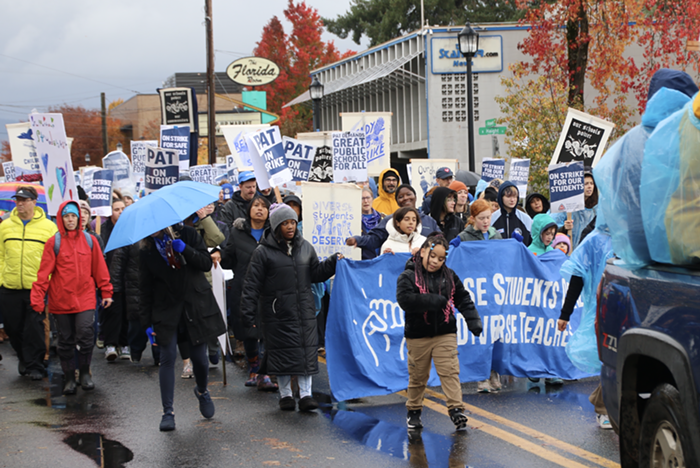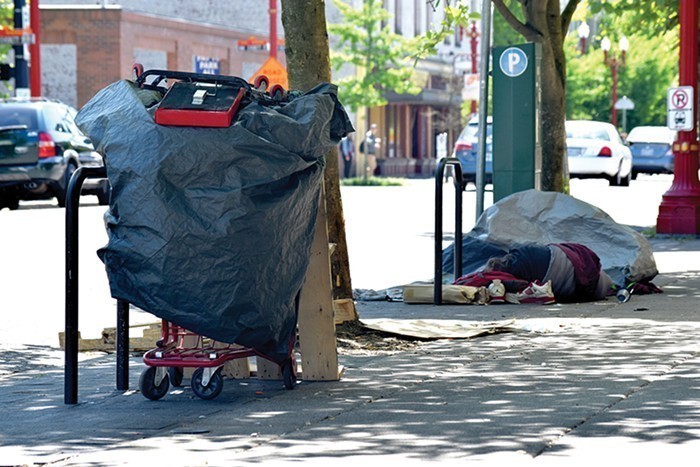
The Portland Bureau of Transportation (PBOT) is repaving Rosa Parks Way, and taking the opportunity to make the street more bike friendly by building a new type of bike lane: one that places a row of parked cars between bicyclists and street traffic. The new lane, called a "parking protected bike lane," falls in line with a street design philosophy proven to prevent cars from hitting bicyclists while also maintaining street parking. The project began in May and is expected to be finished in the fall.
“The city of Portland is looking to provide protected bike lanes because they give people the level of comfort they need to go out and ride on the streets," says PBOT Bicycle Program Manager Roger Geller. "It’s a key element to making biking more accessible to more people.”
Other types of protected bike lanes use trees, curbs, or other vertical design elements to create a visual or physical barrier between bicycles and motorized traffic. Take, for instance, Naito Parkway's "Better Naito" protected bike path, where bicyclists have a row of white plastic dividers between themselves and moving cars. On Rosa Parks, that protection will now be provided by parked cars.
"Parking protected bike lanes are fucking death traps," wrote one critic about the project on a Portland transit meme page on Facebook delightfully called "MAXed Out Memes for Overcast Teens." Another commenter pointed out that placing bikes near the curb exposed them to more debris, like broken glass, and that the configuration makes left turns difficult for bicyclists.
Longtime bike advocates are more moderate in their criticism.
“It’s a step above a regular bike lane, I guess,” says Jonathan Maus, editor and publisher of the prolific BikePortland blog. "I think parking protected bike lanes are okay, but far from ideal. It's like having sleeping sharks protect a swimming area at the beach. Given a choice, I'd much rather have curbs or trees protecting bike lanes instead of cars."
But with Rosa Parks, that wasn't an option.
Since the project was folded into a city repaving project, the scope and budget for the redesign are very limited. PBOT says the new protected bike lanes are an inexpensive way to improve bike safety, because it only requires paint and a few signs—not tons of newly poured concrete.
Drivers are still getting the hang of the new configuration—bicyclists have complained that drivers are parking in the bike lane on Rosa Parks, impeding their path.
Some drivers are enraged by the changes: Geraldine Jacobs from Ridgefield, Washington, wrote to the Oregonian that her husband spent several minutes waiting behind parked cars on Rosa Parks to make a right turn, apparently unable to tell the difference between an unoccupied, parked car and a moving one. She complained about the lack of clarity and the lack of parking, and called the traffic changes "absolute madness."
“There’s always a learning curve when you change something. People take some time to adjust to new behaviors,” Geller says.
PBOT will add white plastic posts like those along Naito between the parking and the bike lane to make up for that learning curve. The plastic posts also help address another of Maus's concerns—that there's no protection for bikers when cars aren't parked in the area. But Maus believes the barriers should be less flimsy to provide real protection. “You’ve got to have hard surfaces, trees, concrete, tire strips,” he says.
Although bicyclists and drivers have their grievances, studies show that protected lanes are safer than unprotected lanes. And Portland now designs its parking protected bike lanes with built-in gaps near cross streets—that way, parked cars don't prevent bicyclists and drivers from seeing each other during turns.
Still, Maus hopes that PBOT and the city's elected officials grow bolder with bike-related design.
“Every time we try to maintain convenience for driving, it comes at a cost for other people on the road,” he says. “The city needs to be more demonstrative with their bike facility designs. It's too timid.”


















